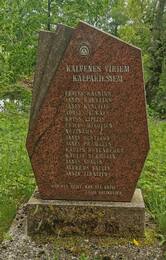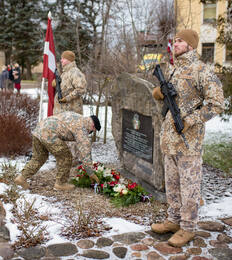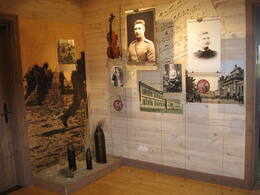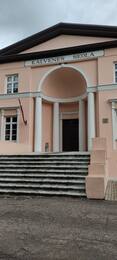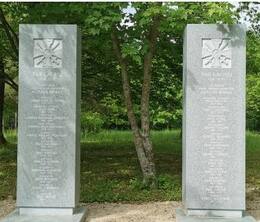Aizporis Manor during the War of Independence
Aizporu Half Manor, Aizpute district, Kalvene municipality, is the westernmost place in Latvia to which Colonel Oskars Kalpaks' separate battalion retreated.
Halfway between Rudbārži and Kalvenė, on the side of the road, is the Aizpore cemetery. There is a monument and 12 memorials to the volunteer soldiers of Oskars Kalpaka's battalion.
In January 1919, after leaving Jelgava through Lielauci, where the first battle of the War of Independence was fought, Colonel Oskars Kalpaks' battalion, after crossing the Venta, reached Lēnā and Rudbārži manors. Early in the morning of January 22, Colonel O. Kalpaks' battalion took up defensive positions at the intersection of the Liepāja - Jelgava highway and the Embūte - Valtaiķi road in the AIZPORU manor area. On the left were the Baltic Landeswehr forces, on the right - the German Iron Division. Since the further attack of the Soviet Latvian forces from Skrunda did not follow, the O. Kalpaks battalion returned to its previous positions near the RUDBĀRŽI manor.
In 1922, former men of the Kalpak Battalion erected a temporary memorial – an oak block with a copper plaque.
In the 1930s, the O. Kalpaks Society commissioned the sculptor Jānis BRIEDIS to create the monument “The Beginning”, and the idea of a large memorial complex with a planted oak tree – the Alley of Heroes – on the Rudbārži Manor was promoted and accepted by the President of Latvia. The rights to implement the memorial site were acquired by sculptor Kārlis JANSONS.
Due to the fact that the main financiers of the monument's creation are the Student Corporations, the J.Briežs monument, made on May 15, 1939, was installed in Pinki (the restored monument is located in Pinki) in honor of the Student Company belonging to the O.Kalpaks Battalion.
In 1940, with the occupation of Latvia, plans for the implementation of the memorial site were halted. According to unofficial information, the planned Alley of Heroes was partially realized with the planting of oak trees from Rudbārži Manor towards Aizporai and can be seen today near the Liepāja-Rīga highway.
Modern memorial site
After the restoration of the Independence of the Republic of Latvia on May 15, 1993, a memorial sign – Ray of Light – was unveiled. The 2.3m high memorial sign, carved in grey granite, was made by sculptors Harijs SPRINCIS and Imants LUKAŽIS (1930 – 2007, buried in the Aizpori cemetery), whose father was also a soldier of the O. Kalpakas battalion. The words of the poet Ed. VIRZAS are engraved on the memorial sign:
FOR THE DAY
AND HER
FOR SOLDIERS
1919
JANUARY 25TH MORNING
FROM HERE
ALSO STARTS
WEAVING LIGHT
COUPLE FOR LATVIA
Sources: Lismanis, J. 1915-1920. In memory of battles and fallen soldiers: Memorial sites of the First World War and the Latvian Liberation Struggle. Riga: NIMS, 1999. p. 177.
Related timeline
Related topics
Related objects
Monument and memorial markers to the soldiers of O. Kalpaka Battalion at Aizpore Cemetery
About halfway between Rudbārži and Kalvė, on the side of an old road parallel to the A9 highway, is the Aizpore Cemetery.
There is a monument and 12 memorials to the volunteer soldiers of Oskars Kalpaka's battalion, who lived in the surrounding houses.
The Aizpore half-manor of the Kalvene municipality was the farthest place to which the Latvian Separate (Kalpaka) Battalion retreated on 22 January 1919. Here the battalion received its first reinforcements from Liepāja - 35 men and launched a counter-attack, reaching Rudbārži on 24 January.
The idea of erecting a monument was conceived in the 1920s, when former soldiers of the 1st Latvian Separate Battalion, or Kalpaka Battalion, erected a temporary memorial sign - a block of oak with a plaque. At that time, the idea of creating a larger memorial ensemble was born, but it was only realised on 15 May 1993, when the memorial sign - the Ray of Light - was unveiled - an obelisk made of grey granite.
The 2.3 m high memorial sign is made by sculptors Harijs SPRINCIS and Imants LUKAŽIS (1930 - 2007, buried in Aizpuri Cemetery), whose father was also a soldier of O. Kalpaka's battalion. The names of the poet E.VIRZA are engraved on the memorial sign:
KALPAKAM
AND HIS
TO THE SOLDIERS
1919
MORNING OF 25 JANUARY
FROM THIS DAY
ALSO FROM
FIRE
OVER LATVIA
At the same time, the graves of the 12 Kalpaks buried in the cemetery were marked with oak memorial plaques, which were replaced by granite markers in 2019.
In the early 1990s, a two-metre-high monument was erected in the cemetery, next to which grows an oak tree planted in the mid-1990s by the legendary actor Ēvalds Valters.
Battle of Skrunda Memorial and Flag Day
The Skrunda Battle Memorial is located in the centre of Skrunda, in Oskaras Kalpaka Park near the Skrunda Culture House, at the intersection of Kuldīgas and Liepājas Streets. In 2005, a stone was erected at the memorial commemorating the battle of 29 January 1919, when the battalion commanded by Oskars Kalpaks, together with the German and Russian units of the Landeswehr, liberated Skrunda from the Bolsheviks. The tradition of Flag Day has been maintained since 2004, commemorating the first town liberated from the Bolsheviks and its liberators, who raised the Latvian flag at the Skrunda church on 29 January 1919.
During the first months of the War of Independence, the Latvian Provisional Government, under pressure from the Bolsheviks, was rapidly losing territory. On 22 January 1919, the Bolsheviks captured Skrunda. A week later, in the early hours of 29 January, the offensive to recapture Skrunda began. The Latvian Separate Battalion under Lieutenant Colonel Oskars Kalpaks was to attack along the Rudbāržu-Skrunda highway and drive the Bolsheviks out of Skrunda. This would be followed by a flank attack by German units with the task of destroying the advancing enemy, while the Russian company would attack between the Latvian and German units, using the Skrunda church as a landmark. The attack was also supported by a German artillery battery. On the day of the attack, the frost was 15 degrees, the sun shone brightly, the Kalpaks had to cross a clear field, and the Bolsheviks were sheltering in the stone buildings of the manor. The Bolsheviks opened fire when the chain of attackers was about 300 metres away, a two-way firefight broke out, and the soldiers under Oskars Kalpaks' command advanced in a rapid advance, forcing the enemy to cease fire and retreat across the Venta. After about 3 hours of fighting, Skrunda was captured at about 9am, with the Latvian Separate Battalion having only 2 wounded.
The Battle of Skrunda was of great importance for the morale of the Latvian Provisional Government's armed Spek soldiers, as it was in fact the first significant victory in the battles against the Bolsheviks. Moreover, the commander himself, Oskars Kalpaks, showed particular courage in the battle, encouraging the soldiers by his example not to be afraid.
Oskars Kalpaks Museum and Memorial Site “Airītes”
The Oskars Kalpaks Museum and Memorial Site Airītes is located between Saldus and Skrunda near the A9 highway. The exhibit has extensive information about Colonel Oskars Kalpaks and his battalion, and shows the history of the Latvian National Army and the memorial site Airītes. The exhibit reveals Colonel Oskars Kalpaks as a personality, as a soldier and as a fighter for Latvia's independence. Audio logs in Latvian, English and German are also available as part of the exhibit. They emphasize the importance of the historic events of 1918/1919 in the protecting the statehood of Latvia. The museum building has been restored.
Entry is free; guided tour – for a fee. The complex has a recreation area, a park, an obstacle course, it is possible to take various classes, and there is a seminar hall for up to 30 people.
Tāšu - Padure Manor
The Tasi - Padure Manor Castle is now known as Kalvene Primary School, founded in 1922. The school building was built in the 19th century in the late classical style as a hunting lodge for Count Keizerling.
At the beginning of 1919, the first mobilised men who answered the call for mobilisation gathered here and came to the manor. On 22 January 1919, the Latvian Separate Cavalry Unit was established here, one of whose leaders went to the 1st Latvian Separate Battalion commanded by O.Kalpaks on 24 January. The whole unit (about 80 soldiers in total) under the command of commander Arnolds Artum-Hartmanis arrived in Rudbārži on 1 March.
Kalvene Primary School is a national cultural monument. In the 1960s, the castle was renovated and adapted to the needs of the school.
Steles in memory of the knights of the Lāčplēsis War Orders
Twenty-seven knights of the Lāčplēsis Military Order are associated with the Aizpute region.
Honoring the soldiers who fell in the Latvian War of Independence, memorial steles of a uniform model were installed throughout Latvia, in which the font of the text engraving corresponds to the standard of the heroes' memorial plaques, which is analogous to the engraving of the sandstone memorial signs of the Riga Brothers' Cemetery and the Central Cemetery Field.
The granite steles were created as part of the Young Guard and Information Center project “Remember Lāčplēšis” dedicated to the centenary of the state of Latvia.







